

| Previous Page | Glass Blowing Menu | Main Menu | Next Page |
|---|
Modern cathode ray tubes have a heated cathode, which releases large numbers of electrons. This tube works in a different way and as a result is much simpler to construct.
A gas normally contains a small number of ions due to natural radioactivity and cosmic rays. When a potential difference is applied, these positive ions are accelerated towards the cathode. If they hit the cathode with sufficient momentum, electrons are ejected. These electrons are now free to be accelerated towards the anode. On their way to the anode, some of these electrons ionize more gas molecules. If the voltage is sufficient a self-sustaining discharge is produced.
When the air pressure in a glass tube is reduced to 10mBar, a steady pink glow discharge can be obtained by applying a sufficiently high voltage. If the pressure is reduced still further to the order of 0.01mBar, the glow discharge becomes almost invisible and the walls of the tube fluoresce. The fluorescence is green with soda glass and blue with lead and borosilicate glass. The glow is caused by excitation due to electron collisions. The brightness can be increased by orders of magnitude by coating the inside of the tube with a thin layer of zinc sulphide (ZnS).
My completed tube is shown below. The bulb on the right has been coated on the inside with a thin layer of ZnS. The glass to metal seals were made using pins recovered from radio valves. There are more details about this on the Glass to Metal Seals page.

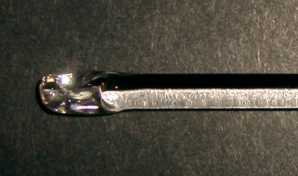 To get the ZnS into the tube,
I made a spatula from a short length of glass rod. I shaped the end of the rod using the
graphite cones. After getting a quantity of ZnS into the bulb which I judged to be enough,
I added a few drops of isopropyl alcohol using an eye dropper. I rotated the tube to
distribute the ZnS and at the same time, heated it gently with a hot air gun to evaporate
the alcohol. I found that the tube then had to be inverted with the bulb uppermost, because
the alcohol condensed in the tube.
To get the ZnS into the tube,
I made a spatula from a short length of glass rod. I shaped the end of the rod using the
graphite cones. After getting a quantity of ZnS into the bulb which I judged to be enough,
I added a few drops of isopropyl alcohol using an eye dropper. I rotated the tube to
distribute the ZnS and at the same time, heated it gently with a hot air gun to evaporate
the alcohol. I found that the tube then had to be inverted with the bulb uppermost, because
the alcohol condensed in the tube.
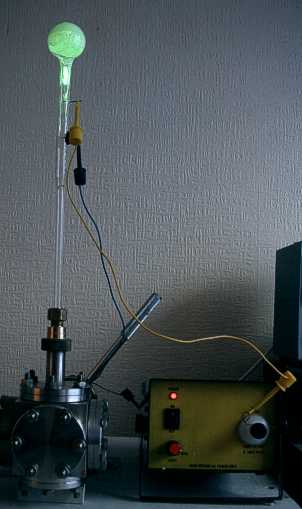 One of the glass to metal
seals went a bit wrong (the left hand one in the top photograph). Due to it persistently
leaking, the tube was not good enough to seal off and I had to make do with operating it
on the pump. I applied a little Apiezon Q wax to stop the leak.
One of the glass to metal
seals went a bit wrong (the left hand one in the top photograph). Due to it persistently
leaking, the tube was not good enough to seal off and I had to make do with operating it
on the pump. I applied a little Apiezon Q wax to stop the leak.
I expected the tube to work with dc high voltage applied. Positive was connected to the
electrode nearest the screen (the anode) and the other electrode (the cathode) was
connected to earth. A round spot about 12mm in diameter appeared on the end of the bulb,
but it dimmed to almost nothing in less than a second. I am fairly convinced that this is
due to the build-up of negative charge on the ZnS. There is no return path back to the
anode.
The tube works continuously with 15kHz ac high voltage applied, but the spot is distorted
in shape. The photographs were taken with ac applied, so that the glow was bright enough to
photograph with my camera.
A pressure of 0.01mBar seems to be about optimal, but it will work down to 0.001mBar.
As the pressure is reduced below 0.01mBar, the spot gets progressively dimmer. Increasing
the pressure above 0.01mBar causes a gas discharge to appear between the two electrodes.
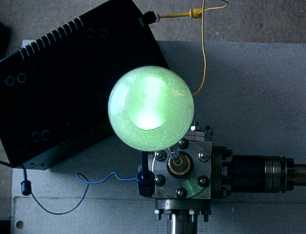 This is a view of the tube from
above. The whole bulb is glowing, but the primary spot is much brighter. The black box
below the bulb is the high voltage supply.
This is a view of the tube from
above. The whole bulb is glowing, but the primary spot is much brighter. The black box
below the bulb is the high voltage supply.
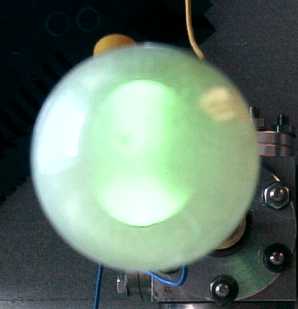 Here, a close-up of the bulb
is shown. There is no magnetic field present and the spot is undeflected.
Here, a close-up of the bulb
is shown. There is no magnetic field present and the spot is undeflected.
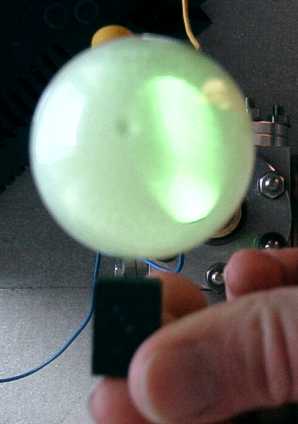 Applying the north pole of
a magnet as in this picture, deflects the glow to the right. This is consistent with the
flow of negative particles towards the screen. In Fleming's left-hand rule, the thumb
points in the direction of the force (or motion), the first finger, the field and the
second finger, the current. Conventional current is in the opposite direction to
electron flow, ie into the screen. The magnetic field is up the screen.
Applying the north pole of
a magnet as in this picture, deflects the glow to the right. This is consistent with the
flow of negative particles towards the screen. In Fleming's left-hand rule, the thumb
points in the direction of the force (or motion), the first finger, the field and the
second finger, the current. Conventional current is in the opposite direction to
electron flow, ie into the screen. The magnetic field is up the screen.
Increasing the voltage increases the brightness of the spot, but decreases the deflection
because the electrons are accelerated to a higher velocity and therefore have
proportionally more momentum.
| Previous Page | Glass Blowing Menu | Main Menu | Next Page |
|---|